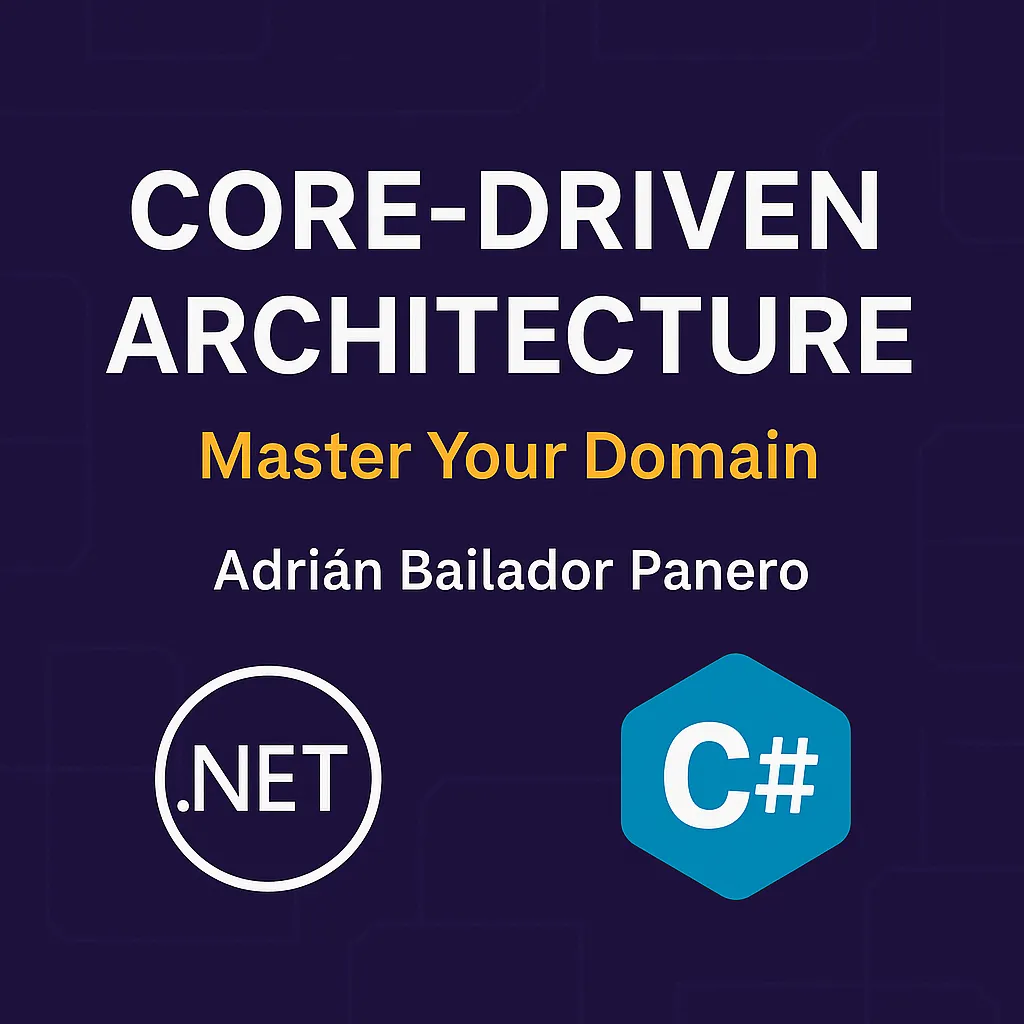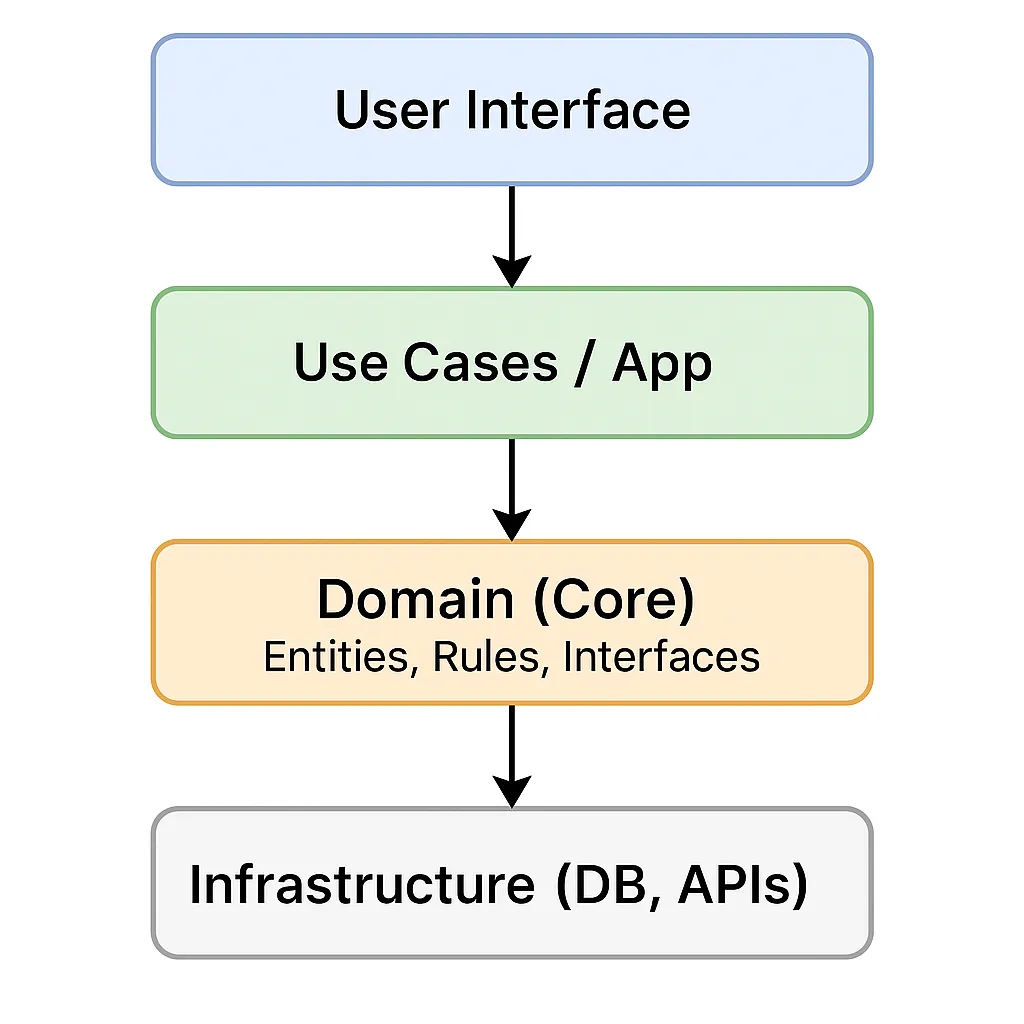
Core-Driven Architecture: Master Your Domain
A practical and in-depth guide to structuring business-logic-centred applications.
🧠 What is Core-Driven Architecture?
Core-Driven Architecture is based on a fundamental idea: the heart of the system must be the business domain, completely isolated from technologies, frameworks, or infrastructure. This structure promotes software that is more maintainable, scalable, and testable.
Inspired by approaches such as Clean Architecture, Onion, and Hexagonal, this architecture seeks a balance between solid principles and real-world applicability. Its purpose is to keep the core logic clean and protected from external changes.
🧩 Separation of Responsibilities
The architecture is divided into well-defined layers. Below, each layer is explained with examples and notes on its role.
1️⃣ Application Entry Point
Orchestrates and composes, contains no business logic.
// Program.cs - Entry point
var builder = WebApplication.CreateBuilder(args);
builder.Services.AddScoped<ICreateOrderUseCase, CreateOrderUseCase>();
builder.Services.AddScoped<IOrderRepository, SqlOrderRepository>();
var app = builder.Build();
app.MapPost("/orders", async (CreateOrderDto dto, ICreateOrderUseCase useCase) =>
{
await useCase.Execute(dto);
return Results.Ok();
});
app.Run();2️⃣ Use Case Layer
Contains application logic that orchestrates domain entities.
// Application Layer - Core
public interface ICreateOrderUseCase
{
Task Execute(CreateOrderDto dto);
}
public class CreateOrderUseCase : ICreateOrderUseCase
{
private readonly IOrderRepository _repo;
public CreateOrderUseCase(IOrderRepository repo) => _repo = repo;
public async Task Execute(CreateOrderDto dto)
{
var order = Order.Create(dto.ClientId, dto.Products);
await _repo.Save(order);
}
}3️⃣ External Elements (Infrastructure)
Adapters such as databases, external APIs, frameworks.
// Infrastructure Layer - Persistence adapter
public class SqlOrderRepository : IOrderRepository
{
private readonly AppDbContext _context;
public SqlOrderRepository(AppDbContext context) => _context = context;
public async Task Save(Order order)
{
_context.Orders.Add(order);
await _context.SaveChangesAsync();
}
}🧷 Dependency Inversion
The domain must not depend on technical implementations, only on interfaces. This is solved by injecting dependencies during app startup, as shown earlier (Program.cs).
🆚 Comparison with Other Architectures
| Architecture | Domain Independence | Use Case Oriented | Complexity | Ideal for… |
|---|---|---|---|---|
| Core-Driven | ✅ High | ✅ Explicit | ⚠️ Medium | Evolving systems |
| Clean Architecture | ✅ Very High | ✅ Very structured | ⚠️ High | Experienced teams |
| Hexagonal | ✅ High | ⚠️ Variable | ⚠️ Medium | Complex integrations |
| Traditional Layered | ❌ Low | ❌ Implicit | ✅ Low | Quick MVPs or legacy apps |
🛠️ How to Migrate Towards Core-Driven?
Migration doesn’t have to be total or immediate. It can be done module by module.
- Identify scattered business logic (in controllers, services).
- Extract entities and rules into a
Coreproject. - Create interfaces in the Core for external services.
- Orchestrate use cases from a new application layer.
- Relocate infrastructure to external projects.
- Adjust the entry point to inject dependencies properly.
🧱 Conceptual Diagram

🧪 Effective Testing in Core-Driven
One of the great advantages: you can test without external dependencies.
✅ Domain Test
[Fact]
public void CreateOrder_Succeeds()
{
var order = Order.Create("client123", new[] { "product1", "product2" });
Assert.NotNull(order);
Assert.Equal(2, order.Products.Count);
}✅ Use Case Test with Mock
[Fact]
public async Task Execute_CallsRepository()
{
var repo = new Mock<IOrderRepository>();
var useCase = new CreateOrderUseCase(repo.Object);
await useCase.Execute(new CreateOrderDto { ClientId = "123", Products = new[] { "p1" } });
repo.Verify(r => r.Save(It.IsAny<Order>()), Times.Once);
}⚠️ Important Considerations
While powerful, this architecture isn’t for every context:
- Learning curve: It can be challenging for junior teams.
- Structural overhead: More files and layers to maintain.
- Initial development time: Not ideal for MVPs or quick prototypes.
- Architectural discipline: If layer separation breaks, the value is lost.
❓ FAQs and Common Mistakes
❓ Can I use Entity Framework inside the Core?
No. You must use interfaces like IOrderRepository, leaving EF to the infrastructure adapter.
❓ When is Core-Driven worth using?
When your system has complex logic, grows fast, or requires high maintainability. For simple, short-lived CRUD apps, it may be overkill.
⚠️ Common mistake: Coupling Core to infrastructure
Do not use DbContext, HttpClient, or EF classes inside the Core. That breaks independence.
⚠️ Common mistake: Putting business logic in controllers
Controllers should orchestrate, not decide. Delegate logic to use cases.
🏁 Conclusion
Core-Driven Architecture forces you to think business first, technology second. This allows you to build applications that:
- Scale better
- Adapt more easily to change
- Are easier to test
- Stay clean over time
It’s not the fastest architecture to implement, but one of the most resilient to change. If your system needs to live for many years, it’s a great technical investment.